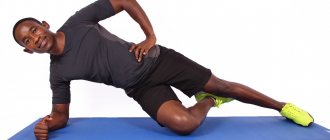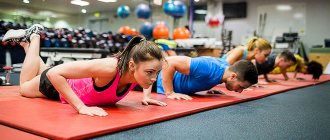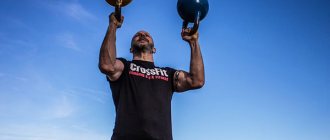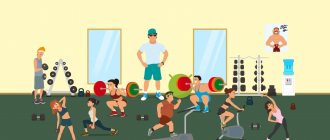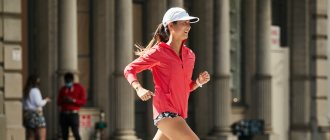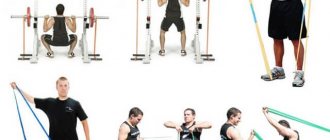Not all women's exercise routines are designed to lose weight. Many workouts are aimed at gaining muscle mass for girls and increasing strength and maintaining an athletic body, rather than just losing fat.
Unfortunately, there is not much information on the Internet about such plans for women in fitness clubs. Despite the fact that you can follow the male regimen, it will be best to give results in a training program in the gym for girls, designed specifically for the fair sex, to be sure of its effectiveness.
In this article, we will discuss the best sets of exercises that can serve as a great start for you in your quest to become slimmer and more athletic.
These days, you're just as likely to see a woman doing basic strength training at the gym as a man.
Years ago, when you walked into a gym, you would have seen a barbell and dumbbell room filled with men and an adjoining cardio room full of women. Girls were often advised to stay as far away from weight training as possible, because many believed that as soon as they touched the barbell, they would turn into pumped-up monsters.
As time has shown, common sense prevailed and people saw that lifting weights does not automatically add 20 kg of muscle mass to women. In fact, research has shown that lifting weights is even better at achieving a leaner, more athletic, and more defined physique than simple cardio.
That's why today we're going to look at the best workout programs for women in the gym who want to get stronger and fitter.
If you are one of them, these plans are perfect for you. We have prepared several complexes that are suitable for beginners and more experienced athletes.
The difference between training women and men
Even though women are increasingly being seen in the gym, that doesn't mean they can follow the same workout plans as men. There are many differences between the two genders and to achieve maximum effect, these differences must be taken into account.
- The male body contains more testosterone. This means that women are more likely to gain fat rather than muscle; and it is also more difficult for them to increase muscle mass and achieve the desired figure. Men have larger hearts and lungs and therefore have a much easier time doing cardiovascular exercises, which have a strong effect on the cardiovascular system and lungs.
- Women have a higher percentage of body fat than men due to the increased amount of estrogen in the body. This is of biological importance, because only a woman’s body can bear a child, and then losing weight is as difficult as losing belly fat after childbirth.
- Greater flexibility, elasticity and mobility of the muscles and joints of the female body makes it more effective when performing various yoga asanas.
- Women require less recovery time after a hard workout.
- Women and men have different amounts of fast-twitch and slow-twitch muscle fibers, which affects fatigue and recovery rates.
Fast, or white muscle fibers, contract quickly and have good explosive power, they are active during sprinting and other intense activities, they grow better, but get tired faster. As fast-twitch muscles tire, they are replaced by slow-twitch fibers that are active during prolonged running, cycling, and other low-intensity activities.
The male body contains more fast-twitch muscles, and women usually have approximately the same number of both types of muscles.
In fact, our individual characteristics play a much greater role in achieving results:
- Women generally have stronger quadriceps than men. This means they need to be careful when doing squats because they have a higher chance of injuring their knees - to prevent this, you need to make sure that the gluteal and abductor muscles are strong enough and well warmed up before starting.
- Women who want to improve the condition of their fast-twitch muscles should look at circuit exercises, with an emphasis on high-intensity training such as sprinting.
- A fitness program in the gym for girls should also include strength exercises that will help strengthen the fragility of women's bones.
Myths and stereotypes about women's training
Once women begin to dive into the world of training, they have no idea how many myths and harmful stereotypes they will encounter there. You need to talk about them so as not to fall under their influence.
About excessive muscularity
Many are afraid that exercise will lead to their figure becoming overly muscular and unaesthetic. In most cases, this is not possible, unless, of course, you start taking incredible amounts of steroids or other testosterone-boosting drugs. Most women simply don't have enough natural testosterone to build the same amount of muscle as men.
By starting to exercise, you are more likely to give your body a sporty and fit look, rather than become pumped up.
About yoga and weakness
Some people believe that yoga and stretching are not effective ways to tone up. Most of these “people” are men, but there are also women among them, and they believe that any kind of flexibility training will lead to improved fitness.
This simply has nothing to do with reality, and any professional fitness trainer will tell you this. Stretching is also very important before starting any workout.
Myths about strength training for girls
- You can easily pump up and become like a man. The opinion that after several strength training sessions you can become a powerful bodybuilder is quite common. However, no amount of training (even at a professional level) can transform a female body type into a male one without the use of steroids. Girls by nature do not have such a high level of testosterone (male hormone) to pump up large muscles with relief. Thanks to strength training, you will build a simply beautiful and toned body!
- Fat can be turned into muscle. Adipose tissue is physiologically unable to become muscle - these tissues are made up of completely different cells! Those. When exercising, you can burn calories (cardio exercise, intense strength training) to speed up the weight loss process and at the same time strengthen your muscles.
- Strength training is extremely dangerous for girls. Exercising with weights can increase the risk of injury if the exercise technique is incorrect, but this fact is absolutely independent of the gender of the athlete (if the movements are carefully and accurately performed, there is no danger).
On the contrary, strengthening your muscles can prevent you from many possible injuries in everyday life and improve your well-being.
- Women's and men's training are fundamentally different. In reality, the training plan and most exercises for working muscles do not differ depending on gender. Any training should include warming up and working out different muscles, regardless of gender or age. The only difference is in the frequency of training, as well as working weight (as a rule, it is higher for men).
The benefits of strength training for women
Lifting weights isn't just about shaping your body. It also has other benefits.
- You will become stronger. This is one of the first and most important effects of strength training that you will notice. And also, increasing the strength of your muscles does not require increasing the amount of muscle itself - which is exactly what many women worry about.
- You will improve the strength of your bones. This is especially important for women with high estrogen levels and low levels of bone strength. Strength training will significantly reduce your bones' tendency to break down.
- You will strengthen your connective tissue. This is the type of tissue that holds your muscles, joints and bones together, and if it gets stronger, it will reduce your chance of damaging them later in life.
- You will improve your mental health. And this is one of the best consequences of strength training. Anxiety, depression, mood swings – moderate, regular exercise will help combat all of this.
If you are new to sports or returning to exercise after a long break, then you may not understand where you need to start. The correct training schedule will depend on many factors: your age, level of training, goals and other individual characteristics of your body.
How to create a schedule for classes?
Whether your goal is to lose weight, improve your health, or get your body in shape, there are three components to a good workout program:
- Cardio: This includes any activity that gets your heart pumping, from walking or running to working out at the gym. Regardless of the exercise you plan to do, it's always a good idea to warm up with 5-10 minutes of light cardio.
- Strength Training: You don't have to lift heavy weights or even spend a lot of time doing strength training, but you should include it in your plan. Your muscles will become stronger, and the larger your muscles, the more calories you burn daily, which will be a good aid in weight loss.
- Flexibility Training: You will need a certain level of flexibility to get the most out of each exercise. Stretching increases your flexibility and helps your body recover from exercise. Some people set aside a separate day for flexibility exercises, but you don't need to. Stretching should be included in every workout you do.
Some people prefer to schedule their workouts with separate days for cardio and strength training, but these exercises can be combined not only with each other, but also with HIIT workouts. Plan your workouts for the week to make sure you're getting enough of each type of exercise in advance.
Strength exercises
Classes in the gym, in particular their main part, must include strength exercises. Depending on the equipment of the gym, as well as the characteristics of a particular workout, this type of load can be performed using weights or with your own weight.
Bodyweight training
| Exercise | Approaches*number of repetitions. | Execution algorithm |
| Walking on the forelimbs | 3*45 sec. | 1. Place your feet at a distance equal to the width of the hip bone; straighten your back. 2. Bend forward and rest the backs of your hands on the floor, placing them in front of your feet. 3. Smoothly transfer the main part of the weight to the forelimbs and, alternately placing them forward, take several “steps” until a straight line is formed passing through the entire body. 4. Without pausing, in similar “steps”, but in the opposite direction, move your hands to the IP. |
| Torso rotations from a sitting position | 4*20 | 1. Sit on a hard surface; bend your legs at the knees and place them in front of you; place your hands on the back of your head; straighten your back. 2. Slightly move your body back without changing the position of your back; lift your feet off the supporting surface. 3. Turn the body to the right and at the same time pull up the lower limb of the same side of the body, while stretching the other as much as possible. 4. Return to IP, then repeat step 3, turning in the opposite direction |
| Squats followed by a jump | 4*15 | 1. Place your feet at a distance equal to shoulder width; straighten your back; move your chest forward slightly; fix your hands on your belt. 2. As you exhale, bend your knees, bringing your buttocks closer to the floor until a parallel is formed between the floor and the back of the thigh. 3. Straighten your lower limbs with a jerking movement and, without stopping in the IP, jump as high as possible. 4. Repeat steps 2-3 as many times as necessary |
Weight training
Weight training is recommended only under the supervision of a professional fitness instructor who is in the gym during the training period. He will be able not only to monitor the correctness of the exercises, but also to provide insurance in the case of an athlete working with heavy weights.
| Exercise | Approaches*number of repetitions. | Execution algorithm |
| Dumbbell bench press | 3*15 | 1. Sit on a horizontal surface, pressing your back as tightly as possible against it; take dumbbells of the required weight in your hands and press them to the chest area; rest your feet on the floor. 2. Inhale deeply, and then “squeeze” the dumbbells with a powerful force so that at the top point they are above the chest area. 3. Without stopping in the upper position, slowly bend your arms at the elbows, returning them to the IP |
| Deadlift (using a barbell) | 4*30 | 1. Stand up straight; place your feet shoulder-width apart; fix the barbell with the required number of weights in your hands; stretch your neck; bend your back slightly forward in the thoracic region. 2. Lean forward without bending your knees and back. 3. Touch the barbell to the floor in the area of the tips of the toes, then immediately, avoiding jerking, return to the IP |
| Lunges with dumbbells | 4*20 for each leg | 1. Position yourself vertically; hold sports equipment of the required weight in your hands; straighten your back; place your feet together. 2. Take a step with your right foot; bend it at the knee, then lower your body to the floor until the knee of your left leg touches the support. The weight when a person is at the lowest point should be equally distributed between both limbs. 3. Return to IP, avoiding sudden movements, then repeat step 2, taking a step with your left foot |
How to start?
There is no single system that will suit absolutely everyone, but examples can help you understand which exercises will suit you.
The examples below are a great place to start, but should not be taken as gospel. First, pay attention to your level of training to understand which plan you should use: beginner, intermediate or experienced.
Beginner's Guide
Before you start, listen to our tips:
- Dive into the world of training with a light cardio program and full-body strength training. If this seems too difficult for you, just start with cardio, that will be enough to get you started.
- You may need more days to rest. It's normal to feel sore muscles after you start exercising, but if you can barely move the next day, then you've clearly overdid it and will cool off during your next workout.
- A typical program for beginners usually includes two to three days of cardio and three days of strength training. These workouts can also be combined with each other if you don't have five days to visit the gym.
- Learn to monitor the intensity of your workouts. Most beginners will start with moderate-intensity exercises. If you can still speak intermittently during the workout, then it is usually at a “medium” intensity.
Warming up and warming up
Before you start exercising, you need to warm up. Not only will this help you improve your flexibility and mobility, but it will also reduce the chance of injury. By warming up your muscles before your workout, you increase the elasticity of muscle fibers. This is important because it helps them not tear during training.
A good warm-up will also raise your body temperature, which will benefit your workout. Warming up starts blood circulation, which leads to more oxygen and nutrients reaching muscle cells. The more energy you have, the better your muscles will be able to work during your workout.
Several exercises with a barbell or dumbbells are not considered a full warm-up.
Sample warm-up plan
Check out a sample warm-up to help your body prepare itself for your workout.
- 1 minute knee raise
- 1 minute foot raise
- 2 sets of 10 circles with each hand
- 10 squats with arms forward
- 20 head turns
- 10 hip rotations
Here's a good pre-workout warm-up with pictures and videos.
All about the benefits and harms of exercise
Strength training allows you to develop:
- Correct posture and good body flexibility by strengthening the muscles around the spine.
- Tight abdominal muscles (necessary to maintain the correct position of the internal organs) and a beautiful, trained stomach.
- A slim and athletic figure, which is not only considered a symbol of health, but also allows you to look younger than your age.
- Proper metabolism within the body (responsible for the absorption of nutrients, providing energy and well-being), as well as rapid blood circulation (prevention of vascular and heart diseases).
- The ability to listen to your own body, muscle function, as well as a lot of positive emotions from your own sporting achievements.
Harm from exercise on exercise machines and with your own weight most often falls into the category of “myths” and rumors. However, a certain danger is still present - injuries due to improper exercise technique, or excess working weight. In this case, attempts to speed up training progress can lead to negative consequences.
The best gym workout programs
Program for 3 days of training per week on simulators
The goal of this three-day complex is to adapt the muscles and nervous system to the loads and master the correct technique for performing exercises on machines and with free weights. Don’t try to lift as much weight as possible, but you shouldn’t slack off either. Feel the work of your muscles, try to love working out in the gym to achieve the desired results as quickly as possible. But don’t overload your body, don’t forget to rest and recover well between fitness trips.
Workout A
1 set of 10 reps (rest 60 sec) | |
1 set of 10 reps (rest 60 sec) | |
2 sets of 10 reps (rest 60 sec) | |
2 sets of 10 reps (rest 60 sec) | |
2 sets of 10 reps (rest 60 sec) | |
2 sets of 10 reps (rest 60 sec) | |
2 sets of 10 reps (rest 60 sec) |
Workout B
2 sets of 15 reps (60 sec rest) | |
2 sets of 15 reps (60 sec rest) | |
2 sets of 15 reps (60 sec rest) | |
2 sets of 15 reps (60 sec rest) | |
2 sets of 15 reps (rest 45 sec) | |
2 sets of 15 reps (rest 45 sec) | |
2 sets of 15 reps (rest 45 sec) |
Workout C
2 sets of 10 reps (rest 60 sec) | |
2 sets of 10 reps (rest 60 sec) | |
2 sets of 10 reps (rest 60 sec) | |
2 sets of 10 reps (rest 60 sec) | |
2 sets of 10 reps (rest 60 sec) | |
2 sets of 10 reps (rest 60 sec) |
Complex for beginners
Below in the table you can see an approximate training program for girls in the gym, which will help you understand what a typical training schedule looks like for beginners or people returning to exercise after a long break. Remember to start each session with 5-10 minutes of cardio and end with stretching exercises.
| Monday | Cardio: 10-30 minutes. |
| Tuesday | Strength exercises for the whole body. |
| Wednesday | Rest or do some gentle yoga or stretching. |
| Thursday | Cardio: 10-30 minutes, you can follow the same set of exercises as on Monday. |
| Friday | Strength training for the whole body. You can use the same set of exercises as on Tuesday, because as you practice the exercises, you will be able to perform them more times each time. |
| Saturday | Rest or do cardio. Stick to something more casual, like a walk or a gentle bike ride. |
| Resurrection | Rest. |
A Guide for Average Athletics
If you've been training for at least three months and doing it regularly, then you most likely fall into this category.
- If you are focused on training for weight loss, then you need to increase the number of cardio sessions 5 (or more) times a week for 20-60 minutes. This is a great time to try interval training once or twice a week, which will be completely worth it. Don't skip strength training. They increase your muscles, speed up your metabolism, and this will have a positive effect on the weight loss process. In addition to working out, to lose weight, you'll need to eat fewer calories than you burn, so watch your diet.
- Your strength training schedule will depend on the type of exercise you're doing (i.e., whole-body or part-body workouts).
- You can combine cardio and strength training in the same day if time allows. It doesn't matter which one you start with, so you can try different combinations until you find the one that works for you.
The plan below includes separate workouts for the upper and lower body, allowing each muscle group to be thoroughly targeted. This will help you increase your muscle tissue and strength.
Example of a plan for people of average athletic training
| Monday | 30 minute cardio Upper body workout Stretching |
| Tuesday | 45-minute interval training on the treadmill Ball workout Stretching |
| Wednesday | 30-minute gentle cardio workout (two sets) Lower body workout Lower Body Stretch |
| Thursday | Rest or gentle yoga/stretching. |
| Friday | Full body strength training |
| Saturday | Cardio endurance training. |
| Sunday | Rest. |
A Guide for Experienced People
If you've been exercising regularly and in a variety of ways for several months, you might consider yourself in this category.
- If you already have experience in training, then you have many options for planning your classes. If you want to focus on strength and muscle, you can split up your exercise routine by doing pushing exercises one day and pulling exercises the next.
- You can also increase your cardio by incorporating high-intensity interval training, high-intensity exercise, and other exercises that help burn calories and improve your endurance.
- Your first priority should be rest, which allows your body to recover between high-intensity workouts. This intensity can lead to injury, fatigue and burnout.
Example plan for experienced people
| Monday | Exercises for triceps, shoulders and chest muscles High intensity cardio |
| Tuesday | Lower body exercises |
| Wednesday | Back and tricep exercises Cardio |
| Thursday | Rest or gentle yoga/stretching |
| Friday | Full body exercises |
| Saturday | High Intensity Cardio |
| Sunday | Rest |
Please keep in mind that these are just examples and may not work for you. The most important thing to remember is to start small. Don't confuse the person you want to be with the person you are now. This journey may take you weeks, even months, of experimenting with different exercises and schedules, but eventually you will find what works for you.
Also remember that the routine can be changed every week. In reality, most people do exactly this, listening to their condition. Be flexible and remember that there is no one-size-fits-all program.
Organization of training.
Before we get into creating your training regimens, there are a few things you should know about upper body training.
- If your general training program does not include a “chest day,” which is the case because some women are afraid that it will cause their breasts to shrink in size, then perform more pulling movements than shoulder presses. Why If your front deltoids predominate in development, which are mainly involved in bench presses, and the rear deltoids lag behind in development, this will give your figure a stoop. And the best way to avoid this is to train your back to a greater extent, of course, not forgetting your shoulders, but with priority on the back and middle bundles. I think you get the point.
- Biceps and triceps exercises should never be the bulk of your upper body work. These are the smallest muscle groups and should only be used for about a quarter of the total upper body workout. But the chest, back and shoulders are large muscle groups and their development will have a greater impact on your body.
- Incorporate upper body training into your training regimen at least twice a week.
Read also: Training plan for women, part No. 6: Abs/Calves.
4 Week Gym Workout Plan for Women
One of the easiest ways to start strength training is to create your own workout plan and start following it. You can follow the workout plan below for as long as you want, confident that you are increasing the weight you lift over time to get maximum results.
Day 1
On the first day, you will focus on your chest and arms.
- Bench press, 4 sets of 8 reps each.
- Push-ups, 4 sets of 10 reps (if 10 reps is too easy for you, you can use weights).
- Dumbbell flyes, lying on a bench at an angle, 3 sets of 15 reps.
- Biceps curls, 3 sets of 12 reps.
- Reverse triceps push-ups, 3 sets of 15 reps.
Day 2
On day two, you'll also do an upper body workout, but focus on your shoulder and back muscles.
- Army barbell standing chest press, 4 sets of 10 reps.
- Seated dumbbell shoulder press, 4 sets of 10 reps
- Lat Pulldown (close grip), 4 sets of 12 reps
- T-bar rows, 4 sets of 10 reps.
- Barbell rows to the chin, 3 sets of 12 reps.
Day 3
The third day is perfect for cardiovascular exercises:
- Plank, 60 seconds, 3 sets.
- Run or cycle (or exercise machine), 20 minutes.
- Burpees, 10 reps.
- Ab crunches, 2 sets of 15 reps.
- Hanging leg raises, 3 sets of 10 reps
Day 4
On day four, we'll move away from high-intensity training and start working on your strength. All of the following exercises should be performed in five sets of five repetitions. Also make sure that the weight being lifted is sufficient.
- Dumbbell Angle Press
- Bench press on a horizontal bench
- Barbell snatch
- Barbell deadlift
- Barbell Chest Raise and Overhead Press
Day 5
On day five, the workout will focus on the muscles of your legs: calves, buttocks, and so on.
- Leg press (simulator), 3 sets of 12 reps.
- Leg curls, 3 sets of 15 reps
- Lunges, 4 sets, 10 reps each leg
- Barbell squats, 4 sets of 8 reps
On days 6 and 7 you will rest and recover
What's next?
Now all that's left to do is do it all! Choose one of the given test workouts and go to the gym. Once you feel comfortable with the types of data complexes that you like, you can start making your own. Just follow these templates and don't be afraid to experiment!
And when you feel more confident, you can add other training methods to these upper body workouts, such as drop sets, where you take the muscle to failure, then reduce the weight of the apparatus by 20-25% and work it to failure again.
You can also do a one-minute cadio between exercises, or do one set of exercises for the abs or buttocks, also between exercises in the program, to further work on lagging muscles.
Happy training!
The role of cardio training
Cardio is not particularly suitable for people who want to get stronger. But, in any case, cardio has a positive effect on health and will be a great addition to your workouts.
There are many benefits to consistent cardiovascular training:
- Increased endurance. You will need to exert less effort to complete many daily tasks, and you will also notice that you have more energy.
- Improved cardiovascular health. You will greatly improve your heart and cardiovascular health if you exercise consistently.
- Faster and better fat loss when compared to solely strength training.
- You will increase your lung capacity, which will allow you to exercise longer and improve your body's oxygenation.
- Statistically, cardio helps manage your blood sugar levels and prevents or helps reduce the symptoms of diabetes.
The Best Cardio Exercises for Women
Most complexes for girls include cardiovascular exercises. If you're looking to add cardio to your plan, we suggest you take a look at the exercises that are best for women:
- Burpee. Burpees are quick deep squats to the floor, a plank jump, and a jumping extension. Burpees are great for burning calories and improving your heart health, as well as your willpower, due to their taxing nature.
- Use a treadmill or exercise bike. Such exercise machines will allow you to do cardiovascular training without leaving your home. Those who still prefer not to stay indoors can, of course, use a regular bicycle or just go for a run around the city.
- Squats with jumps. If squats feel hard, try jump squats. A regular squat, after which you jump as high as you can and then squat down again. These jumps are great for your heart and will strengthen your lower body.
Nutrition
No matter how hard you work in the gym, if you don't eat right, your efforts will be in vain. You cannot train without eating well, so we will share with you some tips and secrets about nutrition for gaining muscle mass for girls.
We are here to become strong and athletic, and without proper nutrition we will not be able to achieve either of these.
The tips below have helped many women achieve good results.
Don't forget about water
Good hydration is important not only for effective training, but also for overall health.
Our body is made up of 80 percent water, so our body requires it to carry out most physiological processes. By not drinking enough water, we put ourselves at risk of dehydration, which will negatively affect not only our workout, but also our overall health.
When we exercise, we lose important electrolytes through sweat. This is why it is important to drink enough water during exercise to replenish your body's water, mineral and electrolyte reserves.
You need approximately 2.5 liters. mineral water per day. Filtered water will also work.
Eat enough protein
Protein is essential for muscle growth and recovery. If you want to become strong and/or athletic, you need to include enough protein in your diet.
Calculate your daily intake at the rate of 1.2-1.5 g of protein per kg of your body weight, and distribute the resulting number over all meals during the day. Choose lean and healthy sources - fish, chicken, turkey, eggs, nuts, dairy products and grass-fed red meat.
Buy quality whey protein
If you can consume milk protein, then whey protein is an important dietary supplement that will help you build muscle and burn fat.
Whey protein shakes are ideal because one shake contains 30 or more grams of protein per serving. They're easy to make, taste great, and are full of the nutrients your body needs to perform efficiently.
Don't forget about vegetables
Like protein, healthy fats and complex carbohydrates, vegetables are an important part of your diet.
Vegetables are full of digestible fiber, rich in vitamins, minerals and antioxidants, and will help add just the right texture and flavor to your dishes.
There is no need to stress about vitamin supplements; instead, just eat enough vegetables.
Supplements to help you improve your results
One of the best ways to get the most out of your workouts is to take a women's specific supplement. There are a great variety of them: natural and synthetic, they will help increase your strength, make your muscles faster and have a positive effect on your performance in the gym.
The most popular additives are:
- Creatine. Creatine helps increase endurance and workout performance. Creatine is also often used in a variety of holistic sports supplements.
- Protein powder. Protein powders are great for people who want to increase their protein intake. Whey protein is considered one of the most popular.
- Vitamin and mineral complexes
. It is advisable to buy and additionally take those vitamins that your body lacks, based on test results. - Omega-3 or fish oil . Polyunsaturated omega-3 fatty acids are needed by the body for the full course of metabolic processes, which will have a positive effect on well-being, appearance and athletic performance.
Conclusion
If you want to start training, know that the results of training in the gym for girls can exceed even your wildest expectations. If you do not interrupt your sports activities and follow our advice, then you should not have problems increasing the strength and endurance of your body, improving its appearance and quality of life in general.
Sources:
- https://crazybulk.com/blog/workout-plans-for-women/
- https://www.verywellfit.com/sample-workout-schedule-1230758
- https://www.lifehack.org/695043/workout-routine-for-women-to-get-strong-and-toned
Exercises on simulators
Classes in the gym, especially those aimed at reducing a person’s body weight, involve performing a number of exercises in simulators and complex installations. During the first lesson, it is recommended to set the minimum load, gradually increasing it in the future as the body gets used to it.
| Exercise | Approaches*number of repetitions. | Execution algorithm |
| Leg press | 3*20 | 1. Be located in the structure of the simulator; press your back to the supporting surface; rest your feet on the moving block; Grab the metal handles with your hands. 2. As you exhale, straighten your legs, using muscle efforts to lift the moving block. 3. Return to IP and, without resting during one approach, repeat the exercise the required number of times |
| Upper block pull | 3*25 | 1. Stand facing the side of the simulator structure; grab the handle with your hands, having previously selected the required level of weight; Place your feet shoulder-width apart; Bend your back slightly forward, moving your buttocks back. 2. Releasing the air that was previously drawn into them from the lungs, pull the handle towards you until the hands are at the level of the lower abdomen. 3. Avoiding jerking, slowly relax your arms, thus taking the original position. |
| "Butterfly" | 3*20 | 1. Sit on the supporting part of the simulator; fix your hands in the movable platforms; rest your feet on the floor. 2. As you exhale, bring the moving platforms together, using the chest muscles as much as possible. The back and legs should remain motionless. 3. After holding for 2-3 seconds, slowly return to IP, relaxing the pectoral muscles as much as possible |
| Breeding legs in the simulator | 3*15 | 1. Sit in the exercise machine, placing your legs in the movable blocks and pressing your back to the supporting surface. 2. Using a powerful force from the muscles of the outer surface of the thigh, move the movable blocks to the sides. Take a pause of up to 5 seconds. 3. Gradually relaxing the muscles, allow the legs to slowly accept the IP |
| Leg abduction in the simulator | 3*15 | The principle of performing this exercise is similar to the above. The only difference is the direction of movement of the moving platforms. In this case, the athlete needs to bring his legs together (using the muscles of the inner thigh), preventing the resistance set by the simulator |
| Pull the lower block towards you | 4*20 | 1. Sit in the simulator; straighten your back; press your feet firmly to the floor; Fix the movable handle in the hands. 2. Simultaneously with exhalation, pull the lower block towards you, making sure that the position of the body remains unchanged. 3. Without pausing during the exercise, return your hands to their original position as slowly as possible. Repeat the exercise as many times as necessary |
Don’t miss the most popular article in the section: Glutamic acid - what it is, why and how it is used in sports and bodybuilding.

